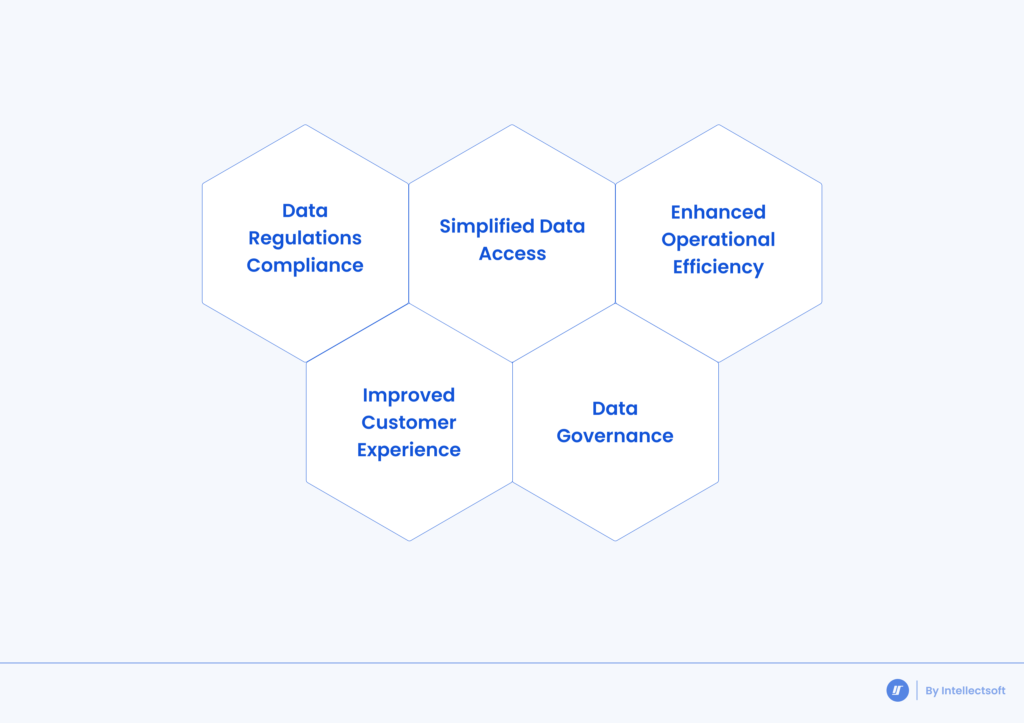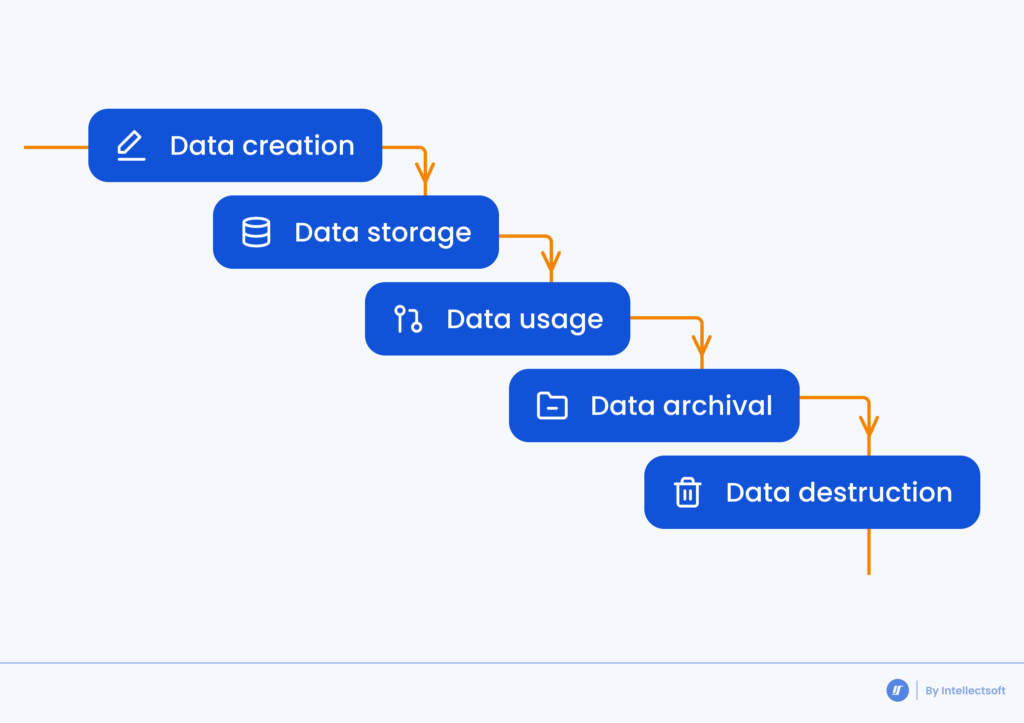In this article, you will learn all the basics about the data governance life cycle, what it is, what are the primary data management steps, and much more useful information below.
Before we proceed with more advanced knowledge, let’s start by giving a brief definition of the data management life cycle and why it’s necessary for your company.

Data lifecycle management is a special approach that involves managing a company's data through a lifecycle, from the data entry to its final destruction. Data is divided into 5 different phases based on various criteria and moves through each of the phases while completing certain tasks or meeting specific requirements. A quality data management life cycle brings structure and organization to a company’s data which leads to better data security and availability. Special data management life cycle processes enable companies to prepare for and minimize risks of data breaches, loss, or system failure as well as boost data recovery practices.
Why is It Important to Follow the Data Governance Lifecycle?
There are a few reasons organizations and businesses should govern data. These include the following:
- To simplify data storage and backup
- To easily evaluate the organization’s data
- To ensure privacy compliance and regulatory compliance
- To break down accumulated data silos
- To avoid data inconsistency
- To prevent data errors and misuse
- To enhance analytics accuracy
- To improve data security
Effective data management enables businesses to resolve data inconsistencies in the organization’s system. Bad data governance can hinder regulatory compliance initiatives as well. With the correctly executed phases of the data life cycle, companies can streamline their internal processes and get access to more deep and accurate analytics and insights to understand clients better and offer improved services. A data management approach makes it possible to collect critical information in a quick and cost-efficient way.
As you can see, the advantages of the data management life cycle are endless. Let’s take a closer look at the core ones and move to explore data governance phases.

Data Regulations Compliance
It’s paramount for a company's security to fully comply with data regulations and one of the most important ones is General Data Protection Regulation. The data management life cycle ensures that businesses can take full advantage of digital technologies and work within a secure and safe environment.
Simplified Data Access
Data lifecycle management can simplify data sharing and availability. It makes it easily accessible for employees who can perform data processing quickly and make more well-informed business decisions while also boosting customer experience.
Enhanced Operational Efficiency
Many companies strive to improve their operational efficiency for better results. Data lifecycle management allows businesses to enhance their efficiency and the efficiency of their IT infrastructure which can potentially lead to streamlined daily operations.
Improved Customer Experience
Data management stages and life cycles enable companies to unlock the potential of their data to better serve their customers and drive more sales.
Data Governance
Cyber training of IT professionals as part of DLM can help businesses reduce the costs related to data management and ensure the data will be correctly collected, managed, and maintained.
Data Management Life Cycle Stages
Now, let’s take a look at the main data management life cycle stages. There are 5 of them and down below you will find a detailed description of each step.

Data Creation
This is the first of the data management phases and the cycle starts with data creation or capture. Data can be represented in various forms and shapes and usually is created by a company in one of three ways: data acquisition, entry, or capture. However, the collection of all the data available isn’t required and the need to capture new data has to be evaluated based on its relevance and quality.
Data Storage
After the data creation, it is stored and protected with the respective level of security. It’s crucial for a company to implement backup and recovery processes for data safety in case of malicious attacks, data corruption, deletion, or accidental alterations. Data can be structured in many different ways depending on the requirements.
Data Usage
This is the most straightforward phase which means the data stored is actively used for achieving business objectives and completing daily tasks and operations. Employees can view, change, process, and save the data. Also, it’s important to maintain an audit trail to ensure that all data modifications are easily traceable. Also, it’s possible to restrict data access according to organizational needs.
Data Archival
At some point, a business will have plenty of data that is no longer useful for daily operations. Archiving data means placing unnecessary data in a separate environment where it can be stored for a certain period of time in case it is needed again by the company. The data is placed in the space with no maintenance or usage.
Data Destruction
This is the final stage of data governance steps and it means that the data has to be purged from an organization’s records and fully destroyed in the most secure way. Companies can delete data they no longer use to create more storage space for new meaningful data. When the archives exceed their volume, all data is removed.

Consider Intellectsoft Your Trusted Partner
If you are looking for a trusted organisation to become your trusted software development partner — Intellectsoft is the perfect match. Our team has more than 15 years of experience and is extremely knowledgeable in the software development process. We have gathered the most qualified specialists on board to offer you the best development services as well as to build the overall digitalization strategy for you while ensuring the top level of privacy for your project.
Our system development life cycle chart is very simple and straightforward. We start with a thorough analysis of the business and after that we proceed with designing, developing, testing, and deploying the final product of the highest quality.
We are here to skyrocket your company and boost your growth. To get familiar with the full list of services we offer at Intellectsoft — follow this link. In case you are interested in enterprise software development services, you can check out our offer and see if it matches your needs. Intellectsoft has vast expertise across various industries including healthcare, construction, fintech, hospitality, logistics, etc.
We have successfully collaborated with dozens of Fortune 500 companies as well as other internationally renowned businesses. Take a look at our most prominent cases to see what software solutions we created and how we helped our clients overcome their main challenges.
If you have any questions or want to discuss your software development idea — don’t hesitate and contact us now. Our specialists will get in touch with you shortly to provide you with the information and assistance you need.
Final Thoughts
As data management is crucial for businesses and their development, we decided to provide you with a basic overview of the core information related to data lifecycle stages and the main advantages it can bring to companies and organizations. We hope it gave you a new perspective on this topic and helped you understand its importance for businesses better.
FAQ
What are the main goals of DLM?
The core goals of a data management life cycle are very simple yet important. It aims at improving data security, preventing errors and data misuse, ensuring regulatory compliance, simplifying data storage, breaking down data silos, and avoiding data inconsistency, as well as making data more accessible.
What is the difference between information management and data management?
Information management is the process of managing people, technologies, and operations that give control over the usage of information needed for business management and business intelligence goals. As information can be physical and electronic, an organization should be capable of managing all the information through a life cycle. And data management is a subset of information management and is the process of creating, changing, sharing, and protecting data as well as making it more easily accessible.
Who is responsible for data lifecycle management?
There are many people who stand behind the phases of data life cycle. Employees who are supposed to take care of this important business aspect include data owners, data stewards, data custodians, data governance committee, and data governance team which can also include a few specialists.